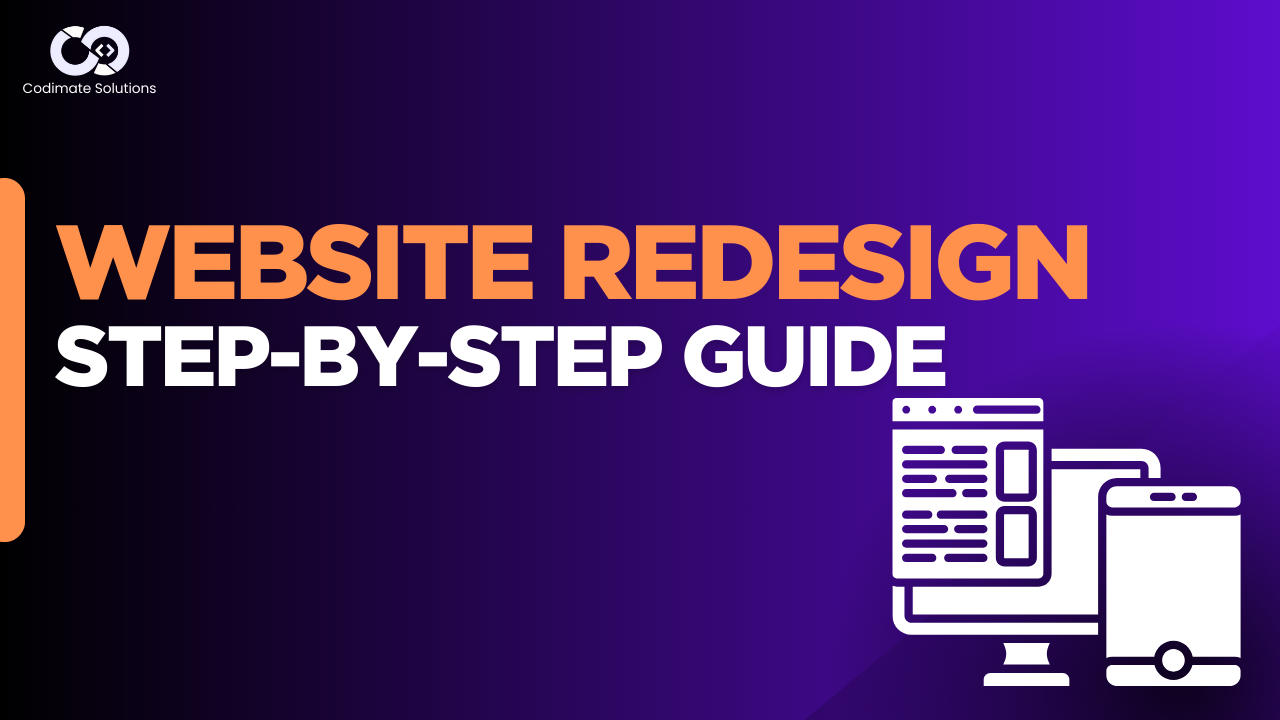How to Plan a Website Redesign Step-by-Step: A Comprehensive Guide
A website redesign is a powerful way to enhance user experience, improve functionality, and align your online presence with modern design trends. Whether you’re refreshing an outdated site or aiming to boost conversions, careful planning is crucial for success. This step-by-step guide provides a detailed roadmap to plan a website redesign, ensuring it meets your business goals and engages your audience effectively. By following these steps, you’ll create a seamless, optimized website that drives results.
Why Plan a Website Redesign?
A website redesign isn’t just about aesthetics—it’s about improving performance, user satisfaction, and business outcomes. Outdated designs, slow loading times, or poor mobile responsiveness can drive visitors away. A well-planned redesign addresses these issues while aligning with your brand’s vision. At Codimate Solutions, we specialize in delivering tailored website development services to help businesses thrive in the digital landscape.
Planning ensures your redesign stays on track, avoids costly mistakes, and delivers measurable results. Let’s dive into the step-by-step process to plan your website redesign effectively.
- Why Plan a Website Redesign?
- Step 1: Define Your Goals and Objectives
- Step 2: Analyze Your Current Website’s Performance
- Step 3: Research Your Target Audience
- Step 4: Create a Content Strategy
- Step 5: Develop a Design and Functionality Plan
- Step 6: Choose the Right Technology Stack
- Step 7: Set a Realistic Timeline and Budget
- Step 8: Test and Optimize Before Launch
- Step 9: Launch and Promote Your Redesigned Website
- Step 10: Monitor and Maintain Your Website
- Common Mistakes to Avoid During a Website Redesign
- Why Choose Codimate Solutions for Your Website Redesign?
- Conclusion
Step 1: Define Your Goals and Objectives
Before starting a redesign, clarify why you’re undertaking the project. Clear goals provide direction and help measure success. Consider what you want to achieve, such as increasing conversions, improving user engagement, or enhancing SEO performance.
Key Questions to Ask:
- Are you aiming to improve user experience or modernize the design?
- Do you want to boost search engine rankings or reduce bounce rates?
- Is the goal to integrate new technologies like Progressive Web Apps (PWAs)?
Write down specific, measurable objectives, such as increasing website traffic by 20% or reducing load times to under two seconds. These goals will guide every decision in the redesign process.
Step 2: Analyze Your Current Website’s Performance
Understanding your website’s strengths and weaknesses is critical. Conduct a thorough audit to identify areas for improvement. This analysis provides data-driven insights to inform your redesign strategy.
Areas to Evaluate:
- User Experience (UX): Are visitors finding what they need easily? Check navigation, content clarity, and bounce rates.
- Performance: Use tools like Google PageSpeed Insights to assess load times and mobile responsiveness.
- SEO: Analyze keyword rankings, backlinks, and on-page SEO elements to identify gaps.
- Design: Does the current design align with modern trends like 3D elements or immersive experiences?
Document issues like outdated visuals, broken links, or poor mobile optimization. This data will serve as a benchmark for your redesign.
Step 3: Research Your Target Audience
A successful website speaks directly to its audience. Research your target users to understand their needs, preferences, and pain points. This ensures your redesign resonates with visitors and drives engagement.
How to Research Your Audience:
- Surveys and Feedback: Ask current users what they like or dislike about your site.
- Analytics: Use Google Analytics to study user demographics, behavior, and device preferences.
- Competitor Analysis: Review competitors’ websites to identify features that appeal to your shared audience.
For example, if your audience values fast, mobile-friendly experiences, consider incorporating PWA development for a native app-like experience. Tailor your redesign to meet user expectations.
Step 4: Create a Content Strategy
Content is the backbone of any website. A redesign is an opportunity to refresh and optimize your content for both users and search engines. Develop a content strategy that aligns with your goals and enhances SEO performance.
Steps to Build a Content Strategy:
- Audit Existing Content: Identify outdated, irrelevant, or underperforming pages.
- Plan New Content: Create fresh, keyword-rich content to address user needs.
- Optimize for SEO: Incorporate relevant keywords naturally, avoiding keyword stuffing.
- Enhance Visuals: Use high-quality images, videos, or kinetic typography to boost engagement.
Work with a professional team like Codimate Solutions to create compelling, SEO-optimized content that drives traffic and conversions.
Step 5: Develop a Design and Functionality Plan
The design and functionality of your website determine how users interact with it. Plan a modern, user-friendly design that incorporates the latest trends while prioritizing performance.
Design Considerations:
- Visual Appeal: Use clean layouts, bold colors, and modern typography.
- UI/UX Best Practices: Follow essential UI/UX design tips for intuitive navigation.
- Accessibility: Ensure your site is ADA-compliant with alt text, readable fonts, and keyboard navigation.
- Trends: Explore AI-powered design tools or immersive 3D elements for a cutting-edge look.
Functionality Considerations:
- Optimize for speed with efficient coding and image compression.
- Ensure mobile responsiveness across all devices.
- Integrate features like e-commerce capabilities for eCommerce websites or CMS for easy updates.
Create wireframes or mockups to visualize the design before development begins.
Step 6: Choose the Right Technology Stack
The technology stack you choose impacts your website’s performance, scalability, and maintenance. Select tools and platforms that align with your goals and budget.
Popular Options:
- CMS Platforms: Use WordPress website development for flexibility and ease of use.
- Custom Development: Opt for custom coding for unique functionality or complex projects.
- PWA Frameworks: Leverage PWAs for fast, app-like experiences.
- AI Integration: Explore AI and machine learning for personalized user experiences.
Partner with Codimate Solutions to select a technology stack that ensures long-term success and scalability.
Step 7: Set a Realistic Timeline and Budget
A website redesign requires careful resource management. Establish a timeline and budget to keep the project on track.
Timeline Tips:
- Small redesigns may take 4–8 weeks, while complex projects can take 3–6 months.
- Break the project into phases: planning, design, development, testing, and launch.
- Allocate time for feedback and revisions.
Budget Considerations:
- Account for design, development, content creation, and testing costs.
- Factor in ongoing maintenance and hosting fees.
- Invest in quality services from providers like Codimate Solutions for better ROI.
Be transparent with your team or agency about budget constraints to avoid scope creep.
Step 8: Test and Optimize Before Launch
Testing ensures your redesigned website is functional, user-friendly, and bug-free. Conduct thorough testing across devices, browsers, and user scenarios.
Testing Checklist:
- Functionality: Verify all links, forms, and features work correctly.
- Performance: Check load times and optimize for speed.
- SEO: Ensure meta tags, alt text, and keywords are in place.
- Usability: Conduct user testing to confirm intuitive navigation.
Use tools like Google Lighthouse to identify areas for improvement. Address any issues before the site goes live.
Step 9: Launch and Promote Your Redesigned Website
A successful launch requires careful execution and promotion. Follow these steps to ensure a smooth rollout.
Launch Steps:
- Back up your existing website to avoid data loss.
- Migrate content and test redirects to maintain SEO rankings.
- Announce the launch via email, social media, and blog posts.
Promotion Tips:
- Share the redesign on platforms like X to reach a wider audience.
- Highlight new features, such as AI-driven search capabilities.
- Update your Google Business Profile and other listings with the new site URL.
Monitor performance post-launch to address any issues quickly.
Step 10: Monitor and Maintain Your Website
A website redesign isn’t a one-time project—it requires ongoing maintenance to stay relevant. Regularly monitor performance and update content to keep users engaged.
Maintenance Tasks:
- Update software, plugins, and security features.
- Refresh content to align with SEO trends.
- Track analytics to measure progress toward your goals.
- Incorporate user feedback to improve functionality.
Partner with Codimate Solutions for ongoing support and maintenance to keep your website performing at its best.
Common Mistakes to Avoid During a Website Redesign
Avoid these pitfalls to ensure a successful redesign:
- Ignoring Mobile Users: Prioritize mobile responsiveness to cater to the growing number of mobile visitors.
- Neglecting SEO: Poor SEO practices can harm rankings and traffic.
- Overcomplicating Design: Keep navigation simple and intuitive.
- Skipping Testing: Launching without testing can lead to user frustration.
By planning carefully and working with experts, you can avoid these mistakes and achieve your redesign goals.
Why Choose Codimate Solutions for Your Website Redesign?
At Codimate Solutions, we understand the complexities of website redesigns. Our team of experts specializes in creating user-focused, SEO-optimized websites that drive results. From CMS development to eCommerce solutions, we offer end-to-end services tailored to your needs.
Our proven process ensures your redesign aligns with your business goals while incorporating the latest trends, such as AI-powered design and sustainable web design. Contact us today to start planning your website redesign.
Conclusion
Planning a website redesign requires a strategic approach to achieve your business objectives. By defining goals, analyzing performance, and prioritizing user experience, you can create a modern, high-performing website. Follow the steps outlined in this guide to ensure a seamless redesign process that enhances your online presence and drives growth.
Ready to transform your website? Partner with Codimate Solutions for expert website development services that deliver results. Start your redesign journey today and stay ahead in the digital world.




